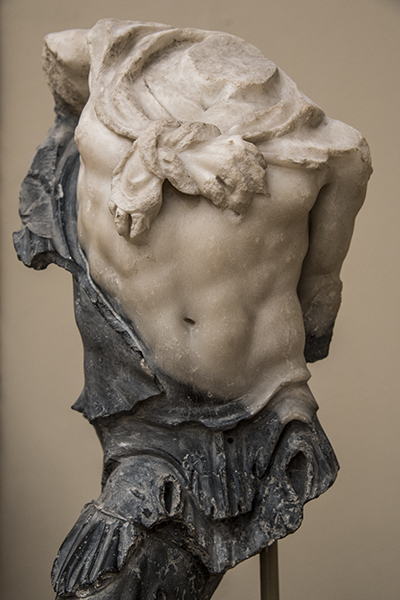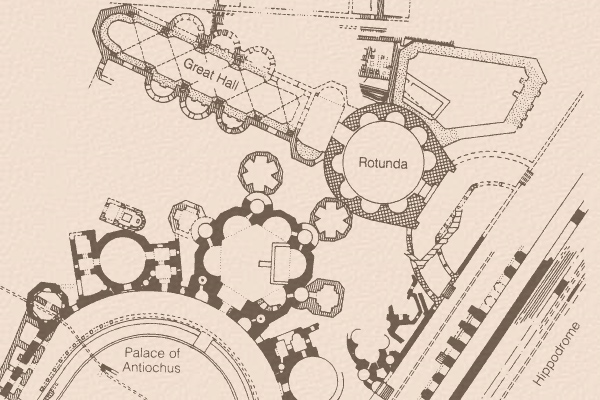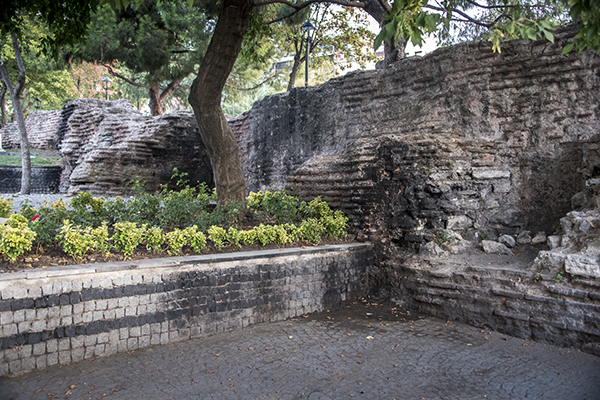
A eunuch at the court of Theodosius II (AD 408–450), Lausus had become imperial chamberlain by at least AD 420, when he was addressed as such ("guardian of our godly and religious empire") in the dedication to The Lausiac History, a collection of biographical sketches of the monastic fathers written in about AD 420 by Palladius. There, without apparent irony, the bishop says of his patron that "When all men are gaping after vain things and building their edifice with stones from which they got no joy, you yourself want to be taught words of edification." The devout Lausus also is described as one who has lessened his own wealth by distributing it to the poor. The bishop of Caesarea, in a letter to Lausus, speaks of his charity as well and that he was very rich and owned a fine house. Although Lausus no longer was in office by AD 422, he may have held it again in AD 431 (and possibly in AD 436) and so was in a unique position to acquire for himself some of the most famous cult statues then being emptied from the pagan temples of the eastern empire. Presumably, it was in the decade after AD 420 that he acquired the Olympian Zeus and Aphrodite of Cnidus, both of which would be lost in the fire of AD 475, when the palace of Lausus was destroyed.
The loss of the Aphrodite is recorded in two Byzantine chronicles, both ultimately derived from a lost history by Malchus of Philadelphia (Amman), who likely flourished during the reign of Anastasius I (AD 491–518). The Suda, a tenth-century Byzantine encyclopedia, indicates that Malchus wrote a history narrating "the burning of the public library and of the statues of the Augusteum [a public square], lamenting them with great solemnity and in the manner of a tragedy"(μ120).
At the end of the eleventh century, Georgius Cedrenus compiled a Chronicle in which he relates that, among the statues in the palace of Lausus, there was "the Cnidian Aphrodite of white stone, naked, shielding with her hand only her pudenda, a work of Praxiteles of Cnidus....the ivory Zeus by Pheidias, whom Pericles dedicated at the temple of the Olympians." In a second passage, he speaks of "a conflagration in the City which destroyed its most flourishing part....[it] also destroyed the porticoes on either side of the street Mesę and the excellent offerings of Lausus: for many ancient statues were set up there, namely the famous one of the Aphrodite of Cnidus....The fire extended as far as the Forum of the great Constantine, as it is called."
In the first half of the twelfth century, Joannes Zonaras (who is best known as the epitimator of Cassius Dio) repeated the second account of Cedrenus, saying that "The fire also destroyed the beautiful palace of Lausus and the statues therein, the Hera of Samos, the Athena of Lindos, and the Aphrodite of Cnidos, famous masterpieces of art," adding that it spread as far as the Forum and that "Malchus, who wrote a history of these Emperors, also mentions this."
A poignant image of such destruction is offered by Evagrius in his Ecclesiastical History, which is the most detailed account of an even more devastating fire that had occurred ten years earlier, on September 2, AD 465 (the Chronicon Paschale records AD 464) in which half the city of Constantinople was destroyed by a conflagration that burned for four days (the Chronicon says thirty).
"Within this area [the city center] nothing remained of any building, public or private—not even the pillars or stone vaults—, but all materials were burned up and reduced to ashes as if they had been easily combustible....To all it offered a miserable and affecting spectacle. Whatever beautiful things had graced the city, all that was built with an eye to unsurpassable magnificence, all that was put to public or private use was at one stroke reduced to hills and mounds of all kinds of rubble, impassable obstacles, the jumbled remains of former beauty. As a result the site did not even allow its inhabitants to recognise what had been there before and where it had stood" (II.13).

Mango identifies the rotunda and adjoining great hall situated between the Mese ("middle street," the main thoroughfare running through Constantinople) and the palace of Antiochus (who was chamberlain in about AD 421) as the palace of Lausus (an attribution supported by its description in the Istanbul Archaeological Museum). And Vickers argues that the collection of pagan statues should be understood as allegorical and arranged in a meaningful fashion. In this Christian interpretation of pagan images, Zeus would have dominated the apse at the end of the great hall, flanked by the youthful figures of Eros and Chronos (Kairos) by Lysippus, their placement signifying the triumph of Virtue over Fortune. On the side of the Eros would have been arranged the statues of Athena, Aphrodite (whose head, facing left would have looked toward Zeus, her father in one genealogy) and Hera (all competitors in the judgment of Paris) and, on the other, statues of animals, both real and imagined.
Bardill locates the palace of Lausus farther west and north of the Mese, nearer the Forum of Constantine, which would place it in the path of the fire of AD 476. Bassett disagrees. If the palace is not to be identified with the great hall and rotunda, as Bardill argues, then the display and interpretation of the statues within the complex becomes uncertain as well. Indeed, she contends that antique statuary was appreciated for its own sake and displayed accordingly, without justification for allegorical interpretation (which, in any event, does not explain the positioning or significance of the other cult images or the animals). Rather, she argues that the statues should be regarded as spoils, plundered from the great sanctuaries of the ancient world and, in their public exposure, signifying the defeat of what they represented. Possession demonstrated domination. Taken from their temples, deconsecrated, and displayed in public (as was the cult statue of Serapis, which was broken up and the head carried through town before being burned), these ancient and once venerated statues (like those on the spina of the Hippodrome) were witness to the triumph of Christianity.

Located in a small park just west of the Hippodrome, the ruins of the hexagonal hall of the Palace of Lausus and limestone blocks of the rotunda still are to be seen.
The broken torso (top) is one of many fragments that were discovered when new building were constructed in the Sultanahmet Quarter. It once may have belonged to the palace collection and now is in the Archaeological Museums (Istanbul).
References: "The Palace of Lausus at Constantinople and Its Collection of Ancient Statues" (1992) by Cyril Mango, Michael Vickers, and E. D. Francis, Journal of the History of Collections, 4(1), 89-98; "The Palace of Lausus and Nearby Monuments in Constantinople: A Topographical Study" (1997) by Jonathan Bardill, American Journal of Archaelogy, 101(1), 67-95; "Excellent Offerings: The Lausos Collection in Constantinople" (2000) by Sarah Guberti Bassett, The Art Bulletin, 82, 1, 6-25; The Fragmentary Classicising Historians of the Later Roman Empire, Vol. II (1983) by R. C. Blockley; The Ecclesiastical History of Evagrius Scholasticus (2000) translated by Michael Whitby; The Lausiac History of Palladius (1918) translated by W. K. Lowther Clarke; The Prosopography of the Later Roman Empire, Vol. II (1980) by J. R. Martindale; "Malchus of Philadelphia" (1977) by Barry Baldwin, Dumbarton Oaks Papers, 31, 91-107..
See also Tivoli.